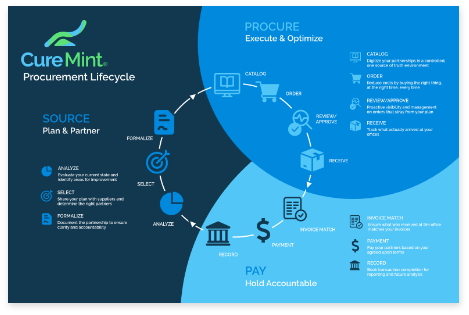When it comes to managing dental practice operations across multiple locations, the procurement side of things can feel a lot like herding cats. This doctor wants to get these products, that doctor wants to get those products, and the other office way over there is going completely off script. Sound familiar?
In order to scale as effortlessly as possible, dental support organizations (DSOs) need to be able to squeeze every ounce of efficiency out of procurement. But if all your dental offices aren’t on the same page, it can be tough to know where to start. Fortunately for both large and emerging DSOs, procurement departments today are well-equipped to measure and quantify performance all the way down to the office level.
With more sophisticated data and reporting tools at their disposal, procurement teams can quickly track spending, formulary compliance, and all the little things in between that add up to costly overhead. This empowers procurement managers to serve a valuable role in identifying and eliminating unnecessary cost burdens for your dental organization – a sure and easy way to raise your EBITDA.
Here are the top 9 KPIs that your procurement department should be tracking and reporting for all your dental offices.
1.) Supply Budget Percentage vs. Actual Supply Spend Percentage
Supply budget percentage vs. actual supply spend percentage is the top KPI for dental procurement teams to monitor. The goal of this KPI is to measure each dental office’s supply spend to see if they are in line, over, or under budget.
Most dental organizations set monthly office budgets based on revenue. Theoretically you can’t predict what your next month’s revenue will be, so a common practice is to take the last 3 months of revenue, average it, then apply x% for whatever your desired spending target is in the upcoming month. This percentage will inform your supply budget – it’s a forward-looking number that serves as a guide for how much money to spend on supplies in the current month.
For example, at an average revenue of $100,000 per month (over the last 3 months), if a supply budget is set at 8% then an office will have a budget of $8,000 (8% of $100,000) to spend on supplies. However, if the current month’s revenue ends up being higher than forecasted, the office can technically go “over” the pre-determined supply budget while still staying in line with the spending target:

Variability in revenue and supply spend can make it difficult to assess each office’s performance with respect to its supply budget. Fortunately, the supply budget percentage vs. actual supply spend percentage KPI is a quick and easy way to see which offices are consistently going over budget. Based on this information, procurement managers can identify offices that are consistently underperforming, diagnose any overspending causes, and address issues that are acting as a drag on your organization’s spend management goals.

2.) On-Formulary/Off-Formulary Report
Dental organizations with multiple offices use a formulary, or supply catalog, that they encourage all doctors to order supplies from. Formularies are a preferred products list intended to make sure all your offices are buying the same products at the same prices, strengthening your purchasing power and driving down supply costs. But if offices are purchasing items off-formulary, not only are they likely getting them at the wrong price, they are also weakening your leverage for price negotiations with suppliers.
The on-formulary/off-formulary report helps DSOs see who is ordering off formulary and how much they are spending. From there, the procurement manager can work with the director of operations or regional clinical doctor and have a discussion to get repeat offenders back to ordering from the formulary. Your procurement department worked hard to negotiate pricing with your vendors – using an on-formulary/off-formulary report is an effective way to make sure your organization is staying on formulary and on track to spend management success.
3.) Primary and Secondary Formulary Utilization Report
While not every dental organization will need more than one formulary, a primary and secondary formulary utilization report is the best KPI to measure which formulary your offices are ordering from and how often.
Maintaining a primary and secondary formulary provides your dental organization with a healthy balance of freedom and control. The primary formulary is a condensed version of all supplies that any of your dental offices would ever need. The secondary formulary is an optional catalog that allows some doctors who want more autonomy to purchase other products.
Dental organizations with more than one formulary may create rules to guide purchasing behavior. For example, a 90/10 rule dictates that 90% of office supply spend should go to the primary formulary with 10% for the secondary formulary. A 75/25 split would be 75% on the primary formulary, 25% on the secondary formulary, etc.
Whatever the split, a primary and secondary formulary utilization report helps procurement teams keep track of formulary usage. A rogue office with a poor track record of using the primary formulary only weakens your purchasing power, ultimately setting you back when it comes time to negotiate with suppliers. Using the primary and secondary formulary utilization report can help identify offices that are regularly going over their secondary formulary percentage so that you or your regional doctor can go talk to them and get them back to the primary formulary.
4.) Order Frequency Report
Another important KPI in dental procurement is order frequency. The order frequency report tells you how many times each office placed an order in the last month. While an order frequency report may not be a significant cost saver, it does help provide more visibility into your order workflow and give you a pulse on your organization’s supply chain.
Most dental organizations have guidelines in place so that each dental office orders supplies once every two weeks, or once per month, or at some other regular interval. Whatever your order volume is, there needs to be a systematic approach to ordering supplies. Otherwise, if offices are ordering every couple days or whenever they happen to run out of supplies, your procurement process may be exposed to small order fees, extra shipping costs, and other unnecessary expenses.
Remember, each order that your organization places requires time and labor to execute. The less orders that you have coming in and going out, the more streamlined your operations can become as you gear your organization for an efficient dental procurement process. An order frequency report is just one way to help get everyone on track and prevent any disorganized or extra ordering.
5.) Backorder Report
An extremely useful procurement KPI for dental organizations is the backorder report. A backorder report is a report that usually comes from your distributor and shows all of the products on your formulary that are on backorder. Backorder reports became very important for dental practices during the PPE shortages brought on by the COVID-19 pandemic and resulting supply shocks.
It is not uncommon for a dental organization to consolidate all of their products to one supplier only to find out that some of the products on their formulary are on backorder. If things are escalating and more and more supplies are on backorder, your procurement department needs to address these issues before they become serious problems that prevent your clinical teams from being able to provide quality patient care. The backorder report gives procurement managers the ammunition they need to have a conversation with their distributor and highlight when backorder frequency is on the rise – creating clear and open communication that holds suppliers accountable.
6.) Small Order Count per Location
Closely related to the order frequency KPI, small order count per location is another helpful procurement KPI for dental organizations. The goal is to establish a report that measures which offices had small order fees and how many orders had small order fees attached to them. Ideally, you want a report for every office that has a small order fee associated with it – this way your procurement department can go to the offices and remind them to hold off on small orders and place larger bulk orders instead.
Small orders for only a few supplies often come with small order fees from the vendor. If each small order fee is $30, for example, and 20 offices have placed small orders in the last week, that’s $600 in expenses your organization could have saved by opting for a bulk order instead. Pairing the small order count report with your order frequency report is a proven way to drive more efficiency and keep ordering costs as minimal as possible.
Of course, dental organizations using procurement solutions like CureMint can prevent these actions from even happening by leveraging order rules to drive the right behavior from the onset.
7.) Transit Times from Order to Receipt
One procurement metric that is especially helpful for smaller dental organizations is transit time from order to receipt. Tracking how long it takes for supplies to reach your offices after ordering them is a great way to measure procurement efficiency and establish a reference point for your distributor’s performance.
If your contract with the distributor says they will deliver supplies in 2-3 days, but your dental offices are actually receiving supplies in 5 days, there is a delay in your order-to-receipt process that can prove to be quite expensive. Do you have enough inventory on hand to get by until the order arrives? Or are your offices forced to close for the day?
There are lots of different ways to gather transit time data – from your procurement platform, the distributor, the shipping provider, etc – but it’s important to keep track of. Monitoring transit time from order to receipt helps to hold your suppliers accountable and ensures that your procurement operations are running smoothly.
8.) PO and Invoice Accuracy
A critical cost-saving KPI for dental procurement and A/P teams is PO and invoice accuracy. Dental organizations need to track when invoices aren’t matching POs – if this happens, it means you are potentially paying more for an incomplete order or an erroneous invoice amount.
Here is where a 3-way invoice match process can help deliver meaningful results. The idea behind 3-way matching is to make sure that your purchase orders match your invoices, and your invoices match what was actually shipped and received at the dental office. This way, a 3-way invoice match provides complete transparency that allows your procurement department to go to a distributor and say, “These invoices are inaccurate, we’re not paying for them.”
Fortunately, with automated 3-way invoice matching for dental practices it’s easier than ever to monitor PO and invoice accuracy for every order placed by your dental organization – saving thousands of dollars in erroneous or duplicate payments.
9.) Returned Products Report per Location
Another procurement KPI that is useful for dental organizations with lots of offices is a returned products report (per location). The returned products report shows all offices that returned products in the last month. It’s an efficiency metric that measures how many and how often supplies are being returned to the distributor by each individual dental office.
Product returns every once in a while are perfectly fine and nothing to be concerned with. But if you see one office returning upwards of 5 products every month, that is something worth investigating further. For starters, an office returning thousands of dollars in product every month is just not good cash flow management, plain and simple. Secondly, the distributor may try to charge more in future price negotiations due to the large volume of returns.
Ultimately, it’s best to keep a returned products report per location and measure each office’s performance from month to month, minimizing the risk of extra costs later on down the line.
Summary
The procurement KPIs listed above are best practices to help you run a seamless and efficient dental procurement operation. Generally speaking, few dental organizations will need to track every one of these procurement KPIs. If you’re operating a smaller DSO, you probably don’t care about backorder reports, or if you’re a solo practitioner you may not need to keep track of returned products so closely.
Instead, treat these KPIs like a salad bar – pick and choose the ones that best match your organization and goals. After collecting and measuring results on a consistent basis, your procurement department will eventually be able to form a framework around establishing cost reduction guidelines that help drive your bottom line for continued growth.
Related Blogs
Dental Procurement vs. Dental Supply Purchasing: What’s the Difference?
11.02.21
As dental practice owners and office managers look into their…
How to Get Started with Dental Spend Management When You Don’t Know Where to Start
09.30.21
For rapidly growing dental service organizations (DSOs), the…
Using Big Data to Lower Dental Supply Costs
09.28.21
As the dental market surpasses $150 billion and private…





